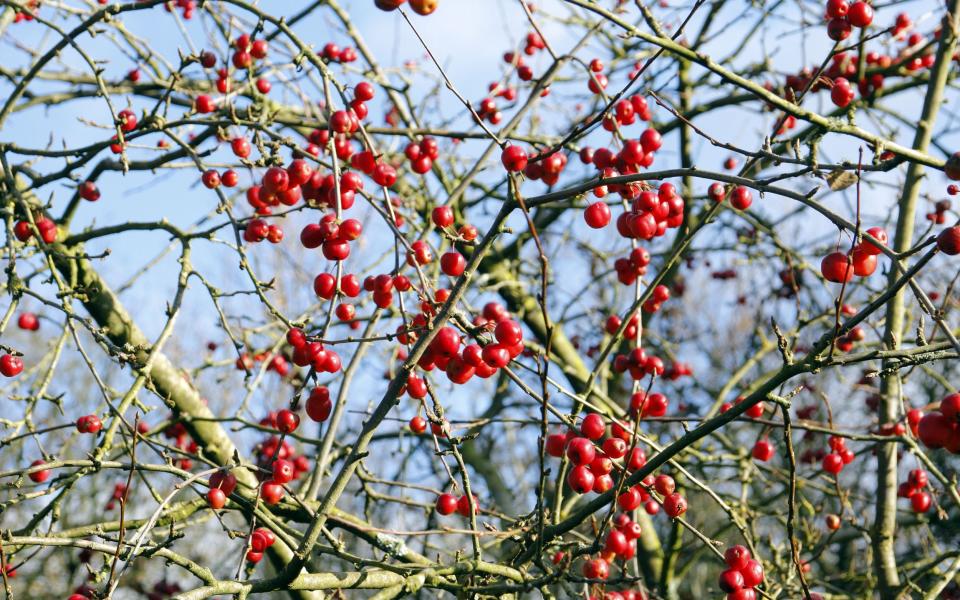How to autumn-proof your garden

When maple-coloured leaves are scattered on the ground, it's a sign that chillier, crisper times are ahead.
As pleasant as their satisfying crunch under your wellies might be, falling leaves can play havoc with ponds, says Tom Brown - who recommends placing a net over them for now, to prevent those very glorious autumn leaves from rotting in the water and causing algae later down the line.
Here are his other suggestions to prepare your garden not only to survive the coming colder months, but to attract wildlife and thrive...
Bold foliage

Rhododendrons and azaleas have fallen out of fashion in recent years, but October is an excellent time to plant them. Rhododendrons have a shallow, dinner-plate-like root system, which makes them sensitive to dry conditions. Avoid such extremes by mulching around the roots of new and existing plantings with well-rotted compost or bark. Classified as ericaceous, rhododendrons and azaleas also need an acidic soil, so if you’re toying with the idea of planting some, peek at neighbouring gardens; if they thrive in your area, there’s a good chance your soil is suitable. I adore the deciduous azaleas as they have colourful scented flowers in late spring, and dramatic autumnal foliage; Rhododendron ‘Narcissiflorum’ is a cracker too. Millais Nurseries (rhododendrons.co.uk) offers a good range.
A fruitful quest

In the eternal search for a small tree that has a long period of interest and will suit smaller gardens, crab apples tick a lot of boxes. ‘Red Sentinel’ is one of my favourites and flowers well during April and May. October heralds the arrival of bauble-like, shiny red fruits, which are produced in abundance all over the tree canopy, and attract wildlife. The fruits persist until Christmas. ‘Red Sentinel’ has won an AGM (Award of Garden Merit) from the RHS; it will reach up to 26ft high and may require pruning in winter to keep a natural-looking shape. Available from many garden centres and pomonafruits.co.uk
New hedges

This is a great time of year to plant new hedges; bare-root hedging plants are widely available in garden centres and specialist nurseries. Hedges offer so many benefits to wildlife compared with fence panels, and late autumn and early winter offer the perfect conditions in which to prepare the soil. Aim for a weed-free, conditioned soil (achieved by forking in lots of well-rotted manure or compost), in which emerging roots from the hedging plants can establish quickly. It’s also worth eradicating perennial weeds, otherwise you’ll be providing a wonderful climbing support for the weed. For a decorative hedge that tolerates exposed sites, try escallonia or elaeagnus. Amelanchier makes a great hedge for wildlife and will give lots of flowers in early summer, too.
Pumpkin power
Before the first frosts, cut pumpkins and squashes in order to cure the skins and store them for months to come. Cut fruits from the main stem, making a T-shape at the top of the pumpkin by leaving a little of the stem at the top of the stalk. This reduces the risk of rot travelling down the stalk and into the pumpkin, jeopardising its storing potential. Place the fruit in a warm and sunny position, either on a windowsill or in a greenhouse, to allow the skin to dry out and become hardened. Avoid damaging the squash, as that will drastically reduce the length of time you can store it. Once cured and hardened, the pumpkin can be stored in a dry, frost-free place – I’ve managed to keep some ‘Crown Prince’ squash until the following March.
Two projects to plan
Time to bring in the tender
Now’s the time to bring tender plants into greenhouses to overwinter them until next year. Unless you garden in a particularly sheltered spot, bring plants such as salvias, marguerites and calla lilies inside to shield them from the extreme winter weather. If practical, I’d suggest moving whole pots into the greenhouse to prevent root disturbance and rot. The plants will be much more resilient to being repotted in spring when growth has begun, and they can recover quickly from the upheaval. Tender plants grow very slowly during autumn and winter so require very little water and no feeding. Water just enough to keep plants alive during the winter, remembering that we can revive a plant that’s too dry, but a sodden root ball in cold weather can be a recipe for disaster.
Don’t leave the leaves
When leaves change colour and we marvel at a glorious autumn, as a gardener, I am filled with mixed emotions. The garden is experiencing one of its most invigorating times of year, but falling leaves can cause havoc with ponds and the never-ending task of clearing them begins. If possible, place a net over ponds and pools to prevent leaves from falling in, sinking and rotting at the bottom. Once all the leaves have fallen, the net can be removed. You’ll find that by catching the falling leaves you’ll prevent the nutrient levels rising in the water, which leads to algae.
Tom Brown is head gardener at West Dean Gardens, West Sussex

